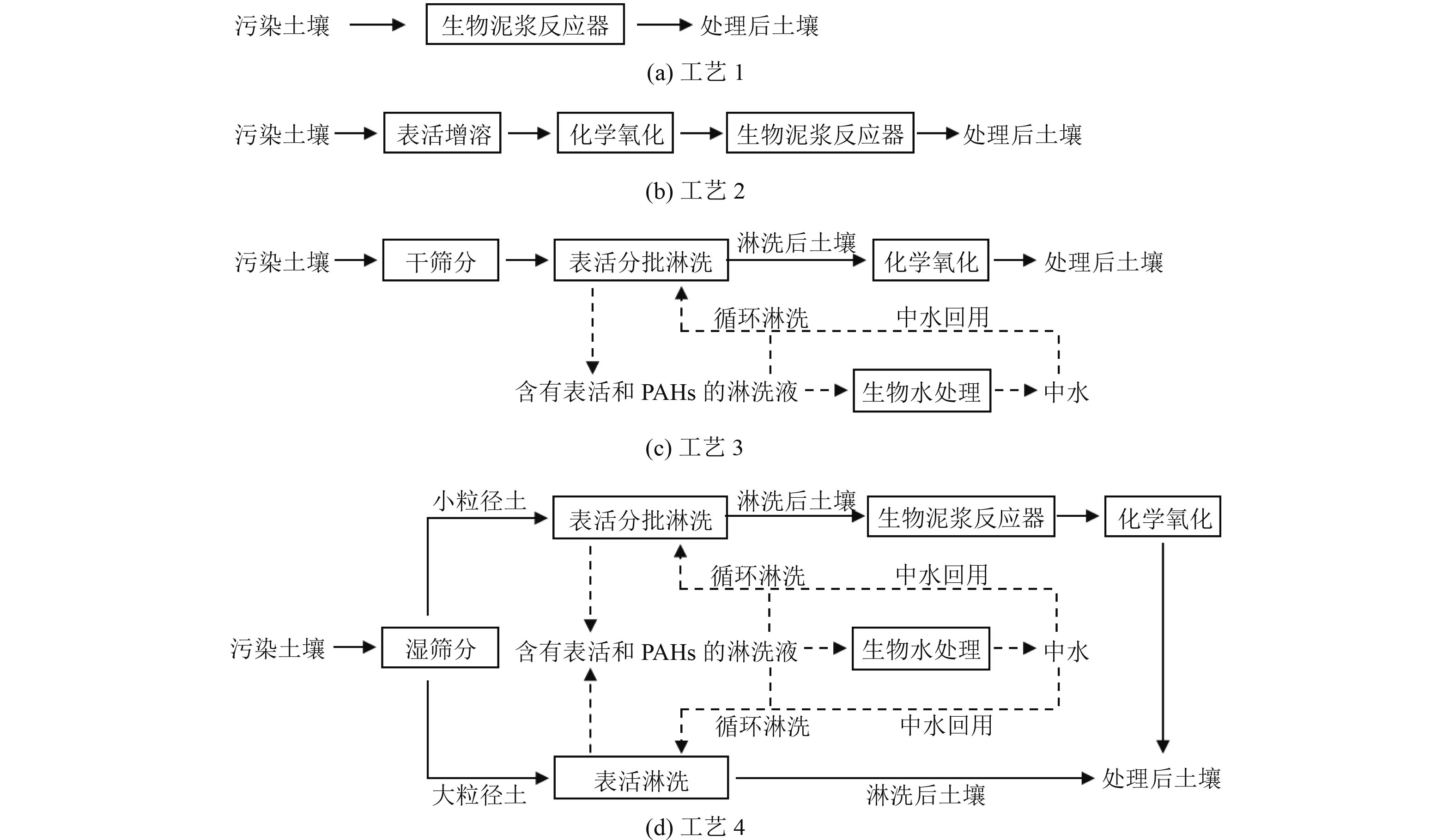Study on the collaborative degradation process based on bioaugmentation for the remediation of polycyclic aromatic hydrocarbons in the soil from a coking plant site
-
摘要:
以某废弃焦化厂的多环芳烃(PAHs)污染土壤为研究对象,通过耦合表活淋洗、生物降解、化学氧化等技术设计了4种修复工艺,并进行了试验验证。结果表明:针对该实际焦化污染土壤,单一的生物泥浆降解工艺21 d后PAHs可实现58.64%的降解率;采用表活增溶+化学氧化+生物泥浆的降解工艺,26 d降解率可达到65.68%,但前置的化学氧化会抑制生物降解效果;采用干筛分+表活分批淋洗+化学氧化的降解工艺降解率可达到85.36%,有效缩短降解时间到13 d内,但土壤中残留的PAHs与土壤颗粒结合紧密,化学氧化降解率仍难以满足大于90%的要求;采用湿筛分+表活分批淋洗+生物泥浆+化学氧化的生物强化协同降解工艺,29 d降解率可达到95.32%,实现了土壤的修复目标。生物强化协同降解工艺路线,综合了多种修复技术的优点,实现了修复技术组合优化,为焦化污染土壤中多环芳烃降解修复提供了可行的工艺路径。
Abstract:Four remediation processes were designed and experimentally validated by coupling surfactants-washing, biodegradation, and chemical oxidation techniques for polycyclic aromatic hydrocarbons (PAHs) contaminated soil from an abandoned coking plant. The results showed that a single soil-slurry bioreactor degradation process could achieve 58.64% PAHs degradation in 21 days for the actual coking-contaminated soil. The degradation process of surfactants-washing+chemical oxidation+soil-slurry bioreactors could achieve 65.68% degradation in 26 days, but the prepositive chemical oxidation would inhibit the biodegradation effect. The degradation process of dry-sieving+surfactants batch washing+chemical oxidation could achieve an 85.36% degradation effect, which could effectively shorten the degradation time to 13 days, but the residual PAHs in the soil were closely bound with soil particles, and the degradation effect of chemical oxidation was still difficult to meet the degradation efficiency of more than 90%. The collaborative degradation process based on bioaugmentation of wet-sieving+surfactants batch washing+soil-slurry bioreactors+chemical oxidation could achieve a 95.32% degradation effect in 29 days and achieved the target value of soil remediation. The collaborative degradation process based on bioaugmentation integrated the advantages of various remediation technologies and realized the optimization of the combination of remediation technologies, which provided a feasible process path for the remediation of PAHs in contaminated soil of coking industry.
-
表 1 干筛分后各粒径污染土壤质量占比以及PAHs浓度占比
Table 1. Mass proportion and PAHs content proportion of contaminated soil with different particle sizes after dry-sieving
粒径划分/mm 土壤质量
占比/%PAHs浓度/
(mg/kg)PAHs浓度
占比/%≤0.075 5.30±1.00 150.00±5.10 8.52±1.40 0.075~1.7 33.15±1.85 159.70±2.70 56.91±0.80 >1.7 61.55±2.85 52.15±2.15 34.57±2.20 表 2 工艺3对污染土壤中PAHs的降解效果
Table 2. PAHs degradation effect of contaminated soil in Process 3
粒径划分 PAHs初始浓度/(mg/kg) PAHs浓度占比% 淋洗后PAHs残留率% 化学氧化后PAHs残留率/% 总PAHs降解率/% 大粒径土(>1.7 mm) 52.15±2.15 34.57±2.20 11.68±2.18 4.03±0.22 95.97±0.22 小粒径土(≤1.7 mm) 158.41±2.88 65.43±2.20 28.94±3.70 20.24±0.10 79.76±0.10 实际污染土壤 93.03±5.46 100.00 85.36 注:大粒径土和小粒径土降解率数据为实测值,实际土壤的降解率数据为计算值(实际土壤的降解率=小粒径土的PAHs浓度占比×小粒径土PAHs总降解率+大粒径土的PAHs浓度占比×大粒径土PAHs总降解率)。 表 3 湿筛分后各粒径污染土壤质量占比以及PAHs浓度占比
Table 3. Mass proportion and PAHs content proportion of contaminated soil with different particle sizes after wet-sieving
粒径划分/mm 土壤质量占比/% PAHs浓度/(mg/kg) PAHs浓度占比/% ≤0.075 32.08±1.48 209.35±4.35 56.51±1.49 0.075~0.25 7.82±2.62 168.35±11.95 20.44±4.38 0.25~1.7 10.17±2.44 111.5±2.10 18.68±5.83 >1.7 49.94±1.67 5.45±0.45 4.37±0.04 表 4 工艺4对污染土壤中PAHs的降解效果
Table 4. PAHs degradation effect of contaminated soil in Process 4
粒径划分 PAHs初始
浓度/(mg/kg)PAHs浓
度占比/%淋洗后PAHs
残留率/%生物降解后PAHs
残留率/%化学氧化后
PAHs残留率/%总PAHs
降解率/%大粒径土(>1.7mm) 5.45±0.45 4.37±0.04 10.90±6.51 89.10±6.51 小粒径土(≤1.7mm) 182.55±4.00 95.63±0.04 35.24±3.30 13.27±0.24 4.40±0.27 95.60±0.27 实际土壤 94.18±5.18 100.00 95.32 注:同表2。 表 5 不同工艺PAHs降解效果对比
Table 5. Comparison of PAHs degradation effects in different processes
工艺 工艺名称 采用的土壤修复技术 修复时间/d 降解率/% 工艺1 生物泥浆 生物修复技术 21 58.64 工艺2 表活增溶+化学氧化+生物泥浆 化学氧化技术、
生物修复技术26 65.68 工艺3 干筛分+表活分批淋洗+化学氧化 土壤淋洗技术、
化学氧化技术13 85.36 工艺4 湿筛分+表活分批淋洗+生物泥浆+化学氧化 土壤淋洗技术、
生物修复技术、
化学氧化技术29 95.32 -
[1] ZHANG T, LIU F, YU X Z, et al. Risk assessment and ecotoxicological diagnosis of soil from a chemical industry park in Nanjing, China[J]. Ecotoxicology,2021,30(7):1303-1314. doi: 10.1007/s10646-020-02320-2 [2] OLAYINKA O O, ADEWUSI A A, OLUJIMI O O, et al. Polycyclic aromatic hydrocarbons in sediment and health risk of fish, crab and shrimp around atlas cove, Nigeria[J]. Journal of Health & Pollution,2019,9(24):191204. [3] KUMAR M, BOLAN N S, HOANG S A, et al. Remediation of soils and sediments polluted with polycyclic aromatic hydrocarbons: to immobilize, mobilize, or degrade[J]. Journal of Hazardous Materials,2021,420:126534. doi: 10.1016/j.jhazmat.2021.126534 [4] BAUER A K, VELMURUGAN K, PLÖTTNER S, et al. Environmentally prevalent polycyclic aromatic hydrocarbons can elicit co-carcinogenic properties in an in vitro murine lung epithelial cell model[J]. Archives of Toxicology,2018,92(3):1311-1322. doi: 10.1007/s00204-017-2124-5 [5] MALETIĆ S P, BELJIN J M, RONČEVIĆ S D, et al. State of the art and future challenges for polycyclic aromatic hydrocarbons is sediments: sources, fate, bioavailability and remediation techniques[J]. Journal of Hazardous Materials,2019,365:467-482. doi: 10.1016/j.jhazmat.2018.11.020 [6] ZHANG L G, QIU X Y, HUANG L, et al. Microbial degradation of multiple PAHs by a microbial consortium and its application on contaminated wastewater[J]. Journal of Hazardous Materials,2021,419:126524. doi: 10.1016/j.jhazmat.2021.126524 [7] 吴枭雄, 王红旗, 刘自力.多环芳烃污染土壤的微生物修复技术研究进展[J]. 环境与发展,2018,30(7):108-109.WU X X, WANG H Q, LIU Z L. Progress in research on microbial remediation of polycyclic aromatic hydrocarbon contaminated soil[J]. Inner Mongolia Environmental Sciences,2018,30(7):108-109. [8] 李凤梅, 郭书海, 张灿灿, 等.多环芳烃降解菌的筛选及其在焦化场地污染土壤修复中的应用[J]. 环境污染与防治,2016,38(4):1-5.LI F M, GUO S H, ZHANG C C, et al. Isolation of PAHs degrading bacteria and its application to mediation of polluted soil in coking site[J]. Environmental Pollution and Control,2016,38(4):1-5. [9] KARIYAWASAM T, DORAN G S, HOWITT J A, et al. Polycyclic aromatic hydrocarbon contamination in soils and sediments: sustainable approaches for extraction and remediation[J]. Chemosphere,2022,291:132981. doi: 10.1016/j.chemosphere.2021.132981 [10] CAO W, YIN L Q, ZHANG D, et al. Contamination, sources, and health risks associated with soil PAHs in rebuilt land from a coking plant, Beijing, China[J]. International Journal of Environmental Research and Public Health,2019,16(4):670. doi: 10.3390/ijerph16040670 [11] 王荔, 张腾飞, 杨苏才, 等.焦化厂PAHs污染土壤中微生物群落多样性特征[J]. 环境工程技术学报,2021,11(4):720-726.WANG L, ZHANG T F, YANG S C, et al. Characteristics of microbial community diversity in PAHs contaminated soil of a coking plant[J]. Journal of Environmental Engineering Technology,2021,11(4):720-726. [12] TRELLU C, PECHAUD Y, OTURAN N, et al. Remediation of soils contaminated by hydrophobic organic compounds: how to recover extracting agents from soil washing solutions[J]. Journal of Hazardous Materials,2021,404:124137. doi: 10.1016/j.jhazmat.2020.124137 [13] PREMNATH N, MOHANRASU K, GURU RAJ RAO R, et al. A crucial review on polycyclic aromatic hydrocarbons: environmental occurrence and strategies for microbial degradation[J]. Chemosphere,2021,280:130608. doi: 10.1016/j.chemosphere.2021.130608 [14] LEMAIRE J, BUÈS M, KABECHE T, et al. Oxidant selection to treat an aged PAH contaminated soil by in situ chemical oxidation[J]. Journal of Environmental Chemical Engineering,2013,1(4):1261-1268. doi: 10.1016/j.jece.2013.09.018 [15] 陈倩, 蔡武, 陈杰, 等.不同化学氧化剂对土壤中多环芳烃的降解效果[J]. 浙江大学学报(工学版),2019(12):2437-2444.CHEN Q, CAI W, CHEN J, et al. Degradation effects of different chemical oxidants on polycyclic aromatic hydrocarbons in soil[J]. Journal of Zhejiang University (Engineering Science),2019(12):2437-2444. [16] KUPPUSAMY S, THAVAMANI P, VENKATESWARLU K, et al. Remediation approaches for polycyclic aromatic hydrocarbons (PAHs) contaminated soils: technological constraints, emerging trends and future directions[J]. Chemosphere,2017,168:944-968. doi: 10.1016/j.chemosphere.2016.10.115 [17] MAO X H, JIANG R, XIAO W, et al. Use of surfactants for the remediation of contaminated soils: a review[J]. Journal of Hazardous Materials,2015,285:419-435. doi: 10.1016/j.jhazmat.2014.12.009 [18] SHANTI, LAMICHHANE K C. Surfactant-enhanced remediation of polycyclic aromatic hydrocarbons: a review[J]. Journal of Environmental Management,2017,199:46-61. [19] GAN S, LAU E V, NG H K. Remediation of soils contaminated with polycyclic aromatic hydrocarbons (PAHs)[J]. Journal of Hazardous Materials,2009,172(2/3):532-549. [20] ZENG J, LIN X G, ZHANG J, et al. Isolation of polycyclic aromatic hydrocarbons (PAHs)-degrading Mycobacterium spp. and the degradation in soil[J]. Journal of Hazardous Materials,2010,183(1/2/3):718-723. [21] ZHENG M M, CAO M H, YANG D H, et al. Enhanced desorption of cationic and anionic metals/metalloids from co-contaminated soil by tetrapolyphosphate washing and followed by ferrous sulfide treatment[J]. Environmental Pollution,2022,296:118688. doi: 10.1016/j.envpol.2021.118688 [22] ZONG Y, MAO Y F, XU L Q, et al. Non-selective degradation of organic pollutants via dioxygen activation induced by Fe(Ⅱ)-tetrapolyphosphate complexes: identification of reactive oxidant and kinetic modeling[J]. Chemical Engineering Journal,2020,398:125603. doi: 10.1016/j.cej.2020.125603 [23] ZHANG C W, KONG C P, TRATNYEK P G, et al. Generation of reactive oxygen species and degradation of pollutants in the Fe2+/O2/tripolyphosphate system: regulated by the concentration ratio of Fe2+ and tripolyphosphate[J]. Environmental Science & Technology,2022,56(7):4367-4376. [24] WANG L, WANG F, LI P N, et al. Ferrous–tetrapolyphosphate complex induced dioxygen activation for toxic organic pollutants degradation[J]. Separation and Purification Technology,2013,120:148-155. doi: 10.1016/j.seppur.2013.10.002 [25] NAKAZAWA M M, GAVAZZA S, KATO M T, et al. Evaluation of rhamnolipid addition on the natural attenuation of estuarine sediments contaminated with diesel oil[J]. Environmental Science and Pollution Research,2017,24(33):25522-25533. doi: 10.1007/s11356-016-7152-9 [26] 麻俊胜, 苟雅玲, 王兴润, 等.化学氧化后深层土壤中多环芳烃的缺氧微生物降解[J]. 环境工程技术学报,2020,10(1):97-104. doi: 10.12153/j.issn.1674-991X.20190067MA J S, GOU Y L, WANG X R, et al. Anoxic biodegradation of polycyclic aromatic hydrocarbons (PAHs) in aged deep soil pretreated with chemical oxidation[J]. Journal of Environmental Engineering Technology,2020,10(1):97-104. doi: 10.12153/j.issn.1674-991X.20190067 [27] DU J Q, LIU J X, JIA T, et al. The relationships between soil physicochemical properties, bacterial communities and polycyclic aromatic hydrocarbon concentrations in soils proximal to coking plants[J]. Environmental Pollution,2022,298:118823. doi: 10.1016/j.envpol.2022.118823 [28] MORA V C, MORELLI I S, ROSSO J A. Co-treatment of an oily sludge and aged contaminated soil: permanganate oxidation followed by bioremediation[J]. Journal of Environmental Management,2020,261:110169. □ doi: 10.1016/j.jenvman.2020.110169 -





 下载:
下载:








